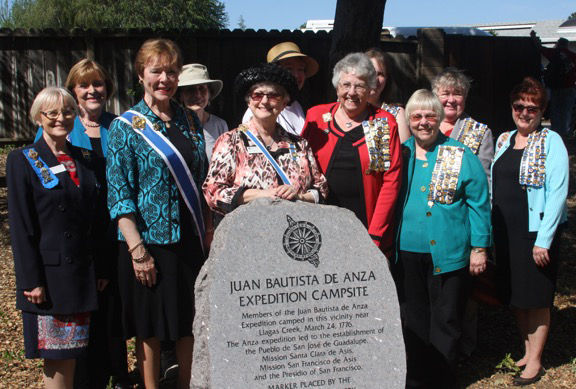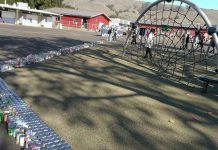
Just over 239 years ago—on March 24, 1776 to be exact—members of the Juan Bautista de Anza expedition stopped in Morgan Hill on their way up the coast in search of an inland supply route from Mexico to northern California.
On March 28, 2015, the California State Society of the Daughters of the American Revolution, along with scores of local and regional dignitaries and descendants of the de Anza family, gathered at the campsite on the banks of Llagas Creek to celebrate the expedition’s 240th anniversary.
The CSSDAR and Morgan Hill Historical Society placed a permanent marker at the de Anza expedition campsite, which is located on an unoccupied property owned by the city of Morgan Hill. The site is now bound by the Woodland Estates Mobile Home Park, Llagas Creek and Santa Teresa Boulevard.
The de Anza expedition started with a party of 240 men, women and children in Tubac, Mexico Oct. 23, 1775, according to CSSDAR Regent Sally Holcombe, who participated in the March 28 ceremony and monument unveiling. Under the leadership of Colonel Juan Bautista de Anza, the purpose of the expedition was not only to establish a supply route up the continent; it was also to establish new grounds for future settlements and enable the colonization of California.
While the families concluded the expedition at Monterey, California March 22, 1776, Anza continued north with a company of 12 soldiers, Holcombe continued. Two days later they camped near what is now Santa Teresa Boulevard in Morgan Hill. From there, the band traveled up the San Francisco Peninsula and back south.
During the trip, the Anza expedition selected settlement sites for what later became the city of San Jose, Mission Santa Clara and Mission Dolores (both in what is now San Francisco) as well as the San Francisco Presidio. The families that traveled with Anza settled throughout California, and the descendants of these early colonial families remain in the state, Holcombe said.
Some of these descendants attended the March 28 monument ceremony in Morgan Hill.
Helping CSSDAR secure the Anza expedition campsite as a historical site and placing the granite marker were the city of Morgan Hill, the National Society of the Daughters of the American Revolution, Morgan Hill Historical Society and Woodland Estates, Holcombe noted.







